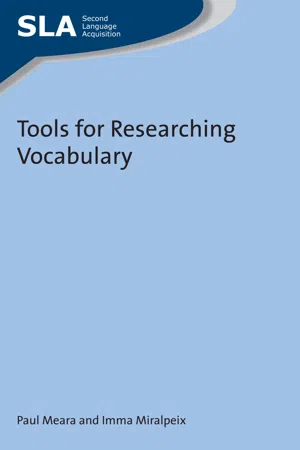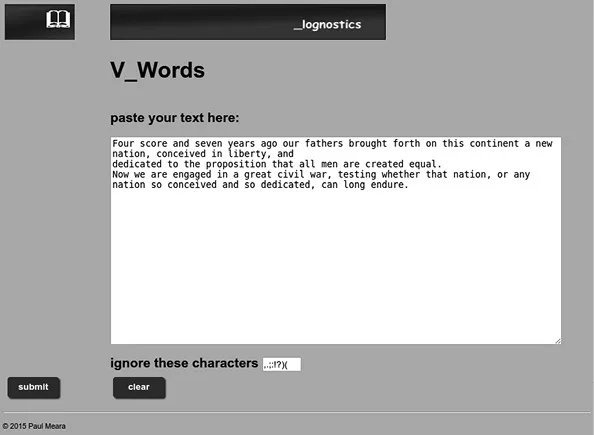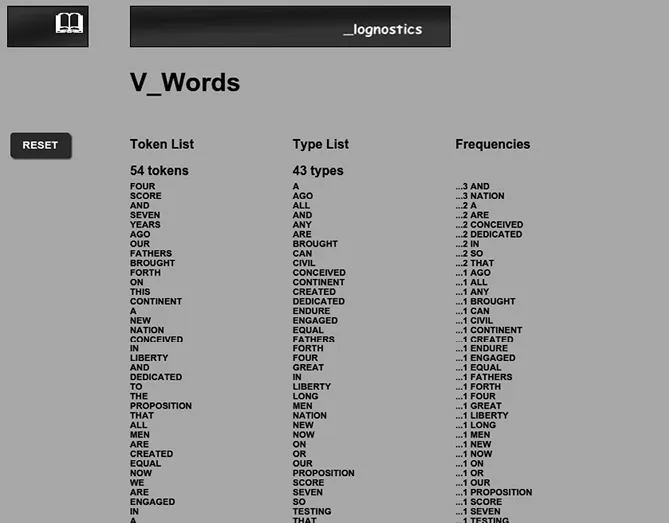![]()
Part 1
Processing Vocabulary Data
![]()
1V_Words v2.0 and V_Lists v1.0
Introduction
This chapter describes two simple programs that are useful for carrying out basic operations on vocabulary data. The programs are not especially innovative: to some extent they duplicate the programs that already exist, some of which are briefly described at the end of the chapter. However, using our programs (V_Words and V_Lists) will help you to become familiar with the conventions used in the other programs in this book.
Part 1. V_Words v2.0
V_Words is a small utility program that turns short texts into word lists. It produces a basic count of all types and tokens in the text, in addition to alphabetical and frequency lists of the word types that the text contains.
Using V_Words
You will find the V_Words program on the Lognostics Tools website, available at: http://www.lognostics.co.uk/tools/V_Words/V_Words.htm.
(1)The V_Words workspace will open for you.
(2)V_Words may require some data preparation so that the text can accurately be turned into lists. There are also some features that you should be aware of before you use the program:
–V_Words is a small program, and it is not designed to be used with very large texts. Your text should be in simple text format and it should not be longer than 8500 words. If your text is longer than this, then you should split it into smaller sections.
–V_Words takes as a word (token) any written unit with a space on either side. Contractions (e.g. he’s, you’d) will be treated as one word unless you replace them by the full forms (he is, you would …).
–We recommend that you add hyphens whenever you want to take different contiguous tokens as just one word (e.g. open compounds: school-bus, phrasal verbs: get-off …).
–The program is NOT case sensitive and therefore uppercase or lowercase letters will not interfere with the counts.
(3)Load the text that you want to work with into the V_Words workspace. You can do this by typing your text directly, or by copying and pasting a pre-prepared text into the workspace. The V_Words workspace looks like Figure 1.1.
Figure 1.1 V_Words workspace
(4)Edit your text as necessary.
(5)V_Words will ignore any punctuation in your text. If you want V_Words to ignore any other symbols, then you can add them to the punctuation list underneath the workspace.
(6)Click the Submit button when your text is ready for analysis.
(7)V_Words generates a report that looks like Figure 1.2. The report contains three columns:
Figure 1.2 V_Words report page
–Column 1 on the left is a simple list of all the words (tokens) in the text. They are presented in the same order as they appear in the text.
–Column 2 is an alphabetically organised type count for the text.
–Column 3 is a frequency ordered type count for the text.
(8)You can save the reports by copying and pasting the relevant columns to a new document.
(9)Click the Reset button to start over with another text.
Even if your research does not involve collecting large word sets, you will find that it is worthwhile experimenting with the V_Words program before you go any further, as many of the features in this program appear in other programs in later chapters. In particular, you need to make sure that you know how to copy and paste a text to be analysed into the V_Words working space, and how to copy and save the results of an analysis back into another document. If you do not know how to do these basic operations, then you need to ask someone to show you before you go any further.
Part 2. V_Lists v1.0
V_Lists allows you to carry out some basic operations on word lists. Specifically, V_Lists takes two word lists as input and reports the words which occur in only one of the lists, the words which occur in both of the lists and a cumulative list that contains words that appear in either of the original lists. This output can be used to perform different types of analyses.
Using V_Lists
You will find the V_Lists program on the Lognostics Tools website, available at: http://www.lognostics.co.uk/tools/V_Lists/V_Lists.htm
(1)The V_Lists workspace will open for you.
(2)V_Lists may require some data preparation in order to produce accurate reports. There are also some features you should be aware of before using the program:
–V_Lists requires two word lists as input. The lists should be in simple text format. Each list will consist of a set of words, one word to a line. The easiest way to prepa...


